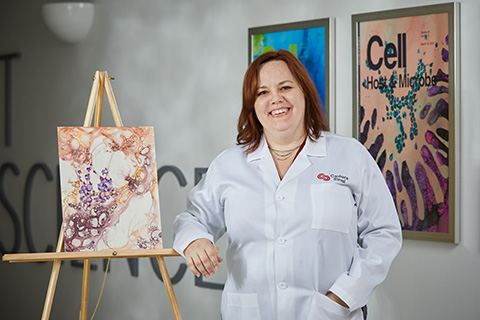Cells Come Alive on Her Canvas
"I walk by it every day and have mixed feelings—excitement and trepidation—a sense of pride while being self-conscious," observed Andrea Wolf, PhD, a research scientist in the Department of Biomedical Sciences.

Andrea Wolf, PhD—standing in front of the "Art of Science" wall featuring her paintings that appeared on journal covers—displays a work in progress of a tissue network being invaded by bacterial-infection-fighting immune cells.
Wolf's daily dose of dichotomous emotions are triggered by a tribute to her dual talents as a scientist and artist.
"It's an honor for an investigator to have a study image on the cover of a peer-reviewed journal. In Dr. Wolf's case, she's the creative force behind five journal covers, and three of those journals additionally featured studies she co-authored or contributed to," explained Loren Karp, program officer at the Inflammatory Bowel and Immunobiology Research Institute (IBIRI). "IBIRI leadership decided to recognize this achievement with a display named 'The Art of Science.'"
Completed last November, the wall display resides on the Davis Building's fourth floor, where Wolf's office and laboratory also are located. Care was taken to create a gallery-like exhibit, with poster-sized prints of each journal cover professionally matted and framed. Black, three-dimensional lettering informs visitors that they're viewing examples of the juncture at which art and science intersect.
"What's particularly unique about Dr. Wolf's creations is they are hand-painted, original art, versus microscopy or other equipment-generated images. I really like her use of color and light touch. Dr. Wolf even makes intestines look beautiful," Karp said, referring to Wolf's most recent cover—the March 12, 2019, issue of Cell Host & Microbe.
In this painting, vibrant, purple-hued intestinal villai (finger-like projections that extend into the small intestine) surround blue, bead-shaped fungi. Wolf's muse was a study she co-authored that linked a common skin fungus to the intestinal disorder Crohn's disease.
An immunologist by training, Wolf received her doctorate in biomedical sciences from the University of California, San Francisco, and came to Cedars-Sinai in 2008. Her research here has focused on cells that are the first to recognize harmful microbes and signal the need for downstream immune responses.
Wolf also has studied the internal degradation that occurs when these cell first responders ingest microbes and has connected this degradation to the onset of inflammation. Wolf is currently examining how pathogen-consuming cells metabolize sugars and if cellular metabolism impacts inflammatory signaling.
While higher education honed Wolf's scientific skills, art classes taken while growing up in Denver, Colorado, contributed to her painting prowess.
"I've been painting and drawing all my life," Wolf said. As an adolescent, she filled many a sketchbook with her favorite cartoon characters. "I was a huge fan of Garfield and his best friend, Odie the dog."
Many of Wolf's colleagues were aware of her downtime devotion to artistic pursuits, so she wasn't surprised when she received her first art-science-painting request from the corresponding author of a study she contributed to that was published in the Nov. 11, 2015, issue of Cell Host & Microbe.
"This painting centers on macrophages—cells that pull in pathogens and eat them. I wanted the painting to read angry, active and convey inflammation," Wolf explained. "That's why the macrophages are shades of red and they're grabbing and consuming microbes."
Wolf's preferred media are Yupo paper (a synthetic paper that's plastic-like, flexible and durable), watercolor and acrylic paint; recently, she has become especially enthusiastic about alcohol ink (fast-drying, highly pigmented, alcohol-based inks used on nonporous surfaces).
"I like alcohol ink because it helps biology come alive with bright colors. It also does its own thing and flows in weird ways," said Wolf. Sometimes she provides a weirdness boost via blow dryer or by tilting the paper. For emphasis or intricacy, Wolf often uses paint pens or artist markers.
"I would describe these paintings as abstract, while also reflecting—to some degree—the physiology of cells and tissues," Wolf noted. "Sometimes I'll take what I see under a microscope and put an artistic spin on it."
When Wolf tackles a potential journal cover, she tends to "start by painting several at the same time. Then I pick the one that's shaping up the best and finish it."
Wolf paints in her home office, lights off (except above the canvas), headphones on (alternative rock playlist) and accompanied by two cats who've been known to wander dangerously close to works in progress.
"I really enjoy doing these paintings. There's a sense of Zen and a calming quality," said Wolf. "Unlike science, there's no right answer."
